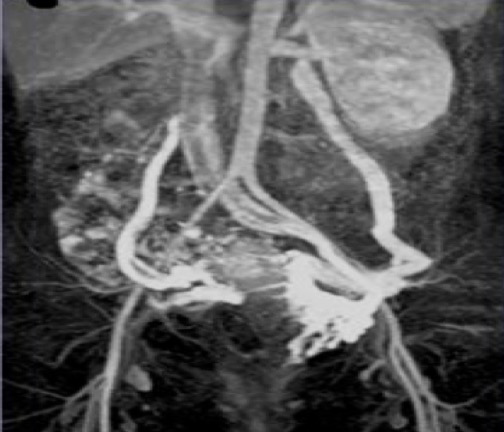State of the Art in the Endovascular Management of Pelvic Congestion Syndrome
DOI:
https://doi.org/10.53903/01212095.126Keywords:
Venous insufficiency, Pelvic pain, DyspareuniaAbstract
Chronic pelvic pain (CPP) is defined as pain in the pelvic area with a duration more than 6 months. It’s an important cause of medical consultation, affecting approximately between 24 and 45% of women in the world. Pelvic congestion syndrome (PCS) is a notable and often under-diagnosed cause of chronic pelvic pain in patients, mostly premenopausal, that significantly affects quality of life. The main objective of this paper is to demonstrate the multiple diagnostic options and different therapeutic devices that are used for selective embolization, giving adequate management and resolution of pelvic congestion syndrome. In conclusion, PCS is a highly painful, disabling and important pathology to take into account due to its high prevalence and associated morbidity. Endovascular treatment has proven to be a highly reliable and safe option, with low complication rates, shorter recovery time, and briefer hospital stays compared to the surgical option. It’s important to know the material and use it correctly which will help avoid complications.
Downloads
References
Hansrani V, Abbas A, Bhandari S, Caress AL, Seif M, McCollum CN. Trans-venous occlusion of incompetent pelvic veins for chronic pelvic pain in women: a systematic review. Eur J Obstet Gynecol Reprod Biol. 2015;185:156-63. doi:10.1016/j. ejogrb.2014.12.011
Brown CL, Rizer M, Alexander R, Sharpe EE 3rd, Rochon PJ. Pelvic congestion syndrome: systematic review of treatment success. Semin Intervent Radiol. 2018;35(1):35- 40. doi:10.1055/s-0038-1636519
Drazic BO, Zárate BC, Valdés EF, et al. Dolor pélvico crónico secundario a síndrome de congestión pélvica. Resultados del tratamiento endovascular de la insuficiencia venosa pelviana y várices genitales [Embolization of insufficient pelvic veins for pelvic congestion syndrome. Analysis of 17 cases]. Rev Med Chil. 2019;147(1):41-6. doi:10.4067/S0034-98872019000100041
O’Brien MT, Gillespie DL. Diagnosis and treatment of the pelvic congestion syndrome. J Vasc Surg Venous Lymphat Disord. 2015;3(1):96-106. doi:10.1016/j. jvsv.2014.05.007
Bookwalter CA, VanBuren WM, Neisen MJ, Bjarnason H. Imaging appearance and nonsurgical management of pelvic venous congestion syndrome. Radiographics. 2019;39(2):596-608. doi:10.1148/rg.2019180159
French S, Daugherty S, Thul S. Pelvic venous disease: identifying this commonly overlooked cause of chronic pelvic pain in women. J Nurse Pract. 2020;16(5):338-43. https://doi.org/10.1016/j.nurpra.2020.02.007
Riding DM, Hansrani V, McCollum C. Pelvic vein incompetence: clinical perspectives. Vasc Health Risk Manag. 2017;13:439-47. doi:10.2147/VHRM.S132827
Corrêa MP, Bianchini L, Saleh JN, Noel RS, Bajerski JC. Pelvic congestion syndrome and embolization of pelvic varicose veins. J Vasc Bras. 2019;18:e20190061. doi:10.1590/1677-5449.190061
Borghi C, Dell’Atti L. Pelvic congestion syndrome: the current state of the literature. Arch Gynecol Obstet. 2016;293(2):291-301. doi:10.1007/s00404-015-3895-7
Antignani PL, Lazarashvili Z, Monedero JL, et al. Diagnosis and treatment of pelvic congestion syndrome: UIP consensus document. Int Angiol. 2019;38(4):265-83. doi:10.23736/S0392-9590.19.04237-8
Taylor HC Jr. Vascular congestion and hyperemia; their effect on function and structure in the female reproductive organs; the clinical aspects of the congestion-fibrosis syndrome.Am J Obstet Gynecol. 1949;57(4):637-53. doi:10.1016/0002-9378(49)90704-8
Tropeano G, Di Stasi C, Amoroso S, Cina A, Scambia G. Ovarian vein incompetence: a potential cause of chronic pelvic pain in women. Eur J Obstet Gynecol Reprod Biol. 2008;139(2):215-21. doi:10.1016/j.ejogrb.2007.11.006
Freedman J, Ganeshan A, Crowe PM. Pelvic congestion syndrome: the role of interventional radiology in the treatment of chronic pelvic pain. Postgrad Med J. 2010;86(1022):704-10. doi:10.1136/pgmj.2010.099473
Ahlberg NE, Bartley O, Chidekel N. Right and left gonadal veins. An anatomical and statistical study. Acta Radiol Diagn (Stockh). 1966;4(6):593-601. doi:10.1177/028418516600400601
Avgerinos ED, McEnaney R, Chaer RA. Surgical and endovascular interventions for nutcracker syndrome. Semin Vasc Surg. 2013;26(4):170-7. doi:10.1053/j.semvascsurg.2014.06.014
Mathis BV, Miller JS, Lukens ML, Paluzzi MW. Pelvic congestion syndrome: a new approach to an unusual problem. Am Surg. 1995;61(11):1016-8
Ashour MA, Soliman HE, Khougeer GA. Role of descending venography and endovenous embolization in treatment of females with lower extremity varicose veins, vulvar and posterior thigh varices. Saudi Med J. 2007;28(2):206-12
Koo S, Fan CM. Pelvic congestion syndrome and pelvic varicosities. Tech Vasc Interv Radiol. 2014;17(2):90-5. doi:10.1053/j.tvir.2014.02.005
Nicholson T, Basile A. Pelvic congestion syndrome, who should we treat and how?Tech Vasc Interv Radiol. 2006;9(1):19-23. doi:10.1053/j.tvir.2006.08.005
Dorobisz TA, Garcarek JS, Kurcz J, et al. Diagnosis and treatment of pelvic congestion syndrome: Single-centre experiences. Adv Clin Exp Med. 2017;26(2):269-76. doi:10.17219/acem/68158
Park SJ, Lim JW, Ko YT, et al. Diagnosis of pelvic congestion syndrome using transabdominal and transvaginal sonography.AJR Am J Roentgenol. 2004;182(3):683-8. doi:10.2214/ajr.182.3.1820683
Jurga-Karwacka A, Karwacki GM, Schoetzau A, Zech CJ, Heinzelmann-Schwarz V, Schwab FD. A forgotten disease: Pelvic congestion syndrome as a cause of chronic lower abdominal pain. PLoS One. 2019;14(4):e0213834. doi:10.1371/journal. pone.0213834
Yang DM, Kim HC, Nam DH, Jahng GH, Huh CY, Lim JW. Time-resolved MR angiography for detecting and grading ovarian venous reflux: comparison with conventional venography. Br J Radiol. 2012;85(1014):e117-22. doi:10.1259/bjr/79155839
Coakley FV, Varghese SL, Hricak H. CT and MRI of pelvic varices in women. J Comput Assist Tomogr. 1999;23(3):429-34. doi:10.1097/00004728-199905000-00018
Laborda A, Medrano J, de Blas I, Urtiaga I, Carnevale FC, de Gregorio MA. Endovascular treatment of pelvic congestion syndrome: visual analog scale (VAS) long-term follow-up clinical evaluation in 202 patients. Cardiovasc Intervent Radiol. 2013;36(4):1006-14. doi:10.1007/s00270-013-0586-2
Edwards RD, Robertson IR, MacLean AB, Hemingway AP. Case report: pelvic pain syndrome--successful treatment of a case by ovarian vein embolization. Clin Radiol. 1993;47(6):429-31. doi:10.1016/s0009-9260(05)81067-0
Almeida GR, Silvinato A, Simões RS, Buzzini RF, Bernardo WM. Pelvic congestion syndrome - treatment with pelvic varicose veins embolization. Rev Assoc Med Bras (1992). 2019;65(4):518-23. doi:10.1590/1806-9282.65.4.518
Castenmiller PH, de Leur K, de Jong TE, van der Laan L. Clinical results after coil embolization of the ovarian vein in patients with primary and recurrent lower-limb varices with respect to vulval varices. Phlebology. 2013;28(5):234-8. doi:10.1258/ phleb.2012.011117
Maleux G, Stockx L, Wilms G, Marchal G. Ovarian vein embolization for the treatment of pelvic congestion syndrome: long-term technical and clinical results. J Vasc Interv Radiol. 2000;11(7):859-64. doi:10.1016/s1051-0443(07)61801-6
Venbrux AC, Chang AH, Kim HS, et al. Pelvic congestion syndrome (pelvic venous incompetence): impact of ovarian and internal iliac vein embolotherapy on menstrual cycle and chronic pelvic pain.J Vasc Interv Radiol. 2002;13(2 Pt 1):171-8. doi:10.1016/ s1051-0443(07)61935-6
Meissner MH, Gibson K. Clinical outcome after treatment of pelvic congestion syndrome: sense and nonsense. Phlebology. 2015;30(1 Suppl):73-80. doi:10.1177/0268355514568067
Chung MH, Huh CY. Comparison of treatments for pelvic congestion syndrome. Tohoku J Exp Med. 2003;201(3):131-8. doi:10.1620/tjem.201.131
Basile A, Marletta G, Tsetis D, Patti MT. The Amplatzer vascular plug also for ovarian vein embolization. Card

Downloads
Published
How to Cite
Issue
Section
License

This work is licensed under a Creative Commons Attribution-NonCommercial-ShareAlike 4.0 International License.
La Revista Colombiana de Radiología es de acceso abierto y todos sus artículos se encuentran libre y completamente disponibles en línea para todo público sin costo alguno.
Los derechos patrimoniales de autor de los textos y de las imágenes del artículo como han sido transferidos pertenecen a la Asociación Colombiana de Radiología (ACR). Por tanto para su reproducción es necesario solicitar permisos y se debe hacer referencia al artículo de la Revista Colombiana de Radiología en las presentaciones o artículos nuevos donde se incluyan.







